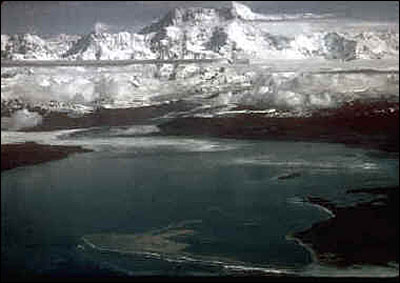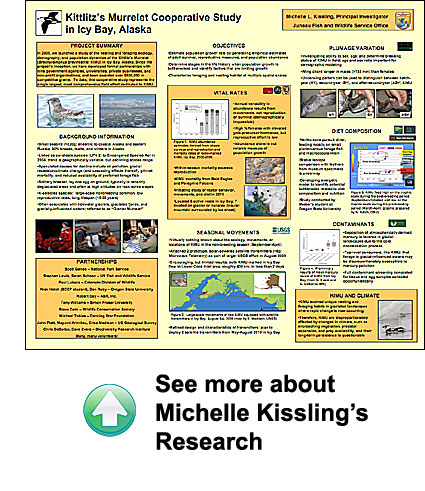Alaska: Conservation Action
 Endemic to coastal Alaska and eastern Russia, the Kittlitz’s Murrelet (Brachyramphus brevirostris) is one of the rarest seabirds in the world. The majority (roughly 90%) of the global population breeds, molts, and winters in Alaska. During the breeding season, this species often associates with tidewater glaciers, and glaciated fjords and streams. Kittlitz’s Murrelets have low reproductive rates: they are non-colonial, likely delay breeding until three years of age, and lay a single egg, typically in recently deglaciated areas and often at high altitudes on rock scree slopes. The winter range of the Kittlitz’s Murrelet is not well known, but based on opportunistic sightings, is likely pelagic.
Endemic to coastal Alaska and eastern Russia, the Kittlitz’s Murrelet (Brachyramphus brevirostris) is one of the rarest seabirds in the world. The majority (roughly 90%) of the global population breeds, molts, and winters in Alaska. During the breeding season, this species often associates with tidewater glaciers, and glaciated fjords and streams. Kittlitz’s Murrelets have low reproductive rates: they are non-colonial, likely delay breeding until three years of age, and lay a single egg, typically in recently deglaciated areas and often at high altitudes on rock scree slopes. The winter range of the Kittlitz’s Murrelet is not well known, but based on opportunistic sightings, is likely pelagic.
The current Alaska population is estimated to be approximately 16,000 birds (nearly half occur in southeast Alaska). This represents a dramatic decline over the past 30 years with declines of up to 18% per year in some core areas. Speculated causes for decline include oil pollution, glacial recession (and cascading effects thereof), gill-net mortality, and reduced availability of preferred forage fish. The fate of the Kittlitz’s Murrelet is likely linked to changes in climate; extirpation in some key populations is predicated as early as 2030.
Conservation Action
Perhaps the greatest impediment to conservation of the Kittlitz’s Murrelet is a lack of information on their biology and factors limiting population growth. Listed by the National Audubon Society as one of the “top ten most endangered birds in the country,” the Kittlitz’s Murrelet is one of the least understood species in North America, with very little known regarding reproductive success, adult survival, and foraging ecology. Thus monitoring efforts should be coupled with directed research efforts to help identify factors limiting population growth of this species.
 The U.S. Fish and Wildlife Service has partnered with the National Park Service, Alaska Department of Fish and Game, Wildlife Conservation Society, Dancing Star Foundation, Colorado Division of Wildlife, and several universities to study these factors at one of the most important population centers: Icy Bay, Alaska. Approximately 10-15% of the Alaska population occurs in Icy Bay during the breeding season and this is the only area where Kittlitz’s Murrlets continue to outnumber all other alcids. Partner commitments and funding to continue this important work have been secured through 2012.
The U.S. Fish and Wildlife Service has partnered with the National Park Service, Alaska Department of Fish and Game, Wildlife Conservation Society, Dancing Star Foundation, Colorado Division of Wildlife, and several universities to study these factors at one of the most important population centers: Icy Bay, Alaska. Approximately 10-15% of the Alaska population occurs in Icy Bay during the breeding season and this is the only area where Kittlitz’s Murrlets continue to outnumber all other alcids. Partner commitments and funding to continue this important work have been secured through 2012.
For More Information
Michelle L. Kissling
U.S. Fish and Wildlife Service
3000 Vintage Blvd., Suite 201
Juneau, AK 99801
(907) 780-1160
Visit the Alaska Region website for the
U.S. Fish & Wildlife Service, and learn more.
